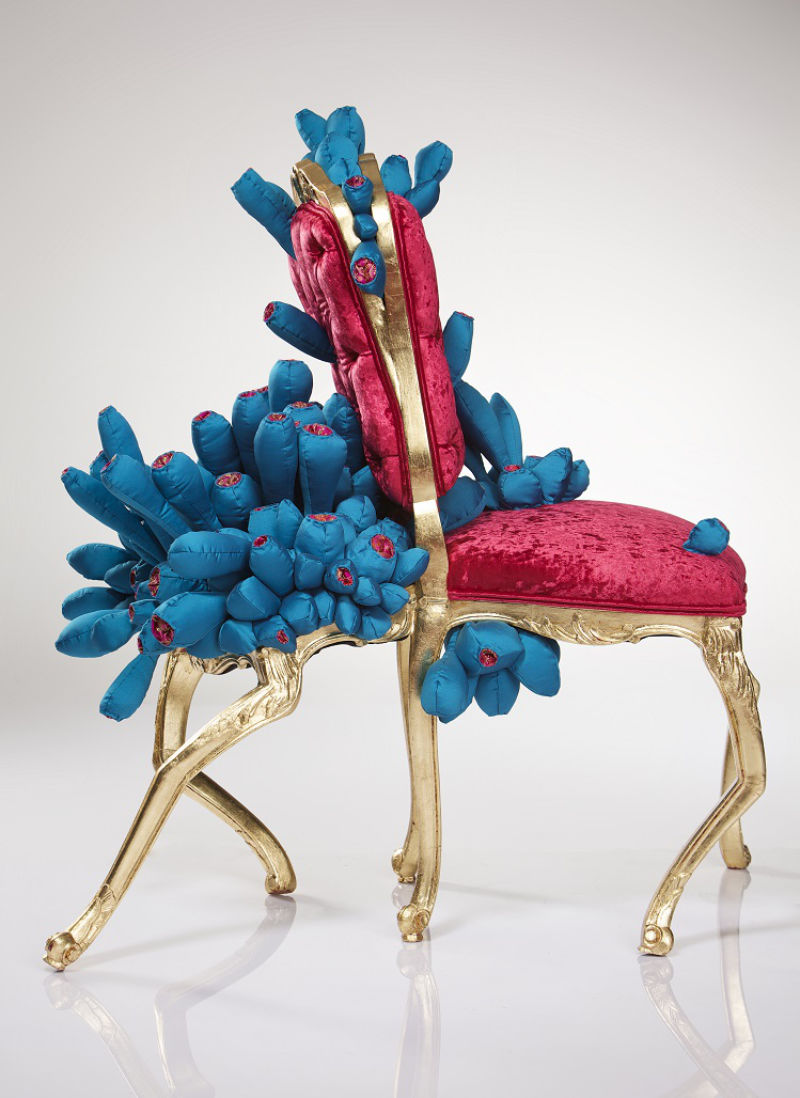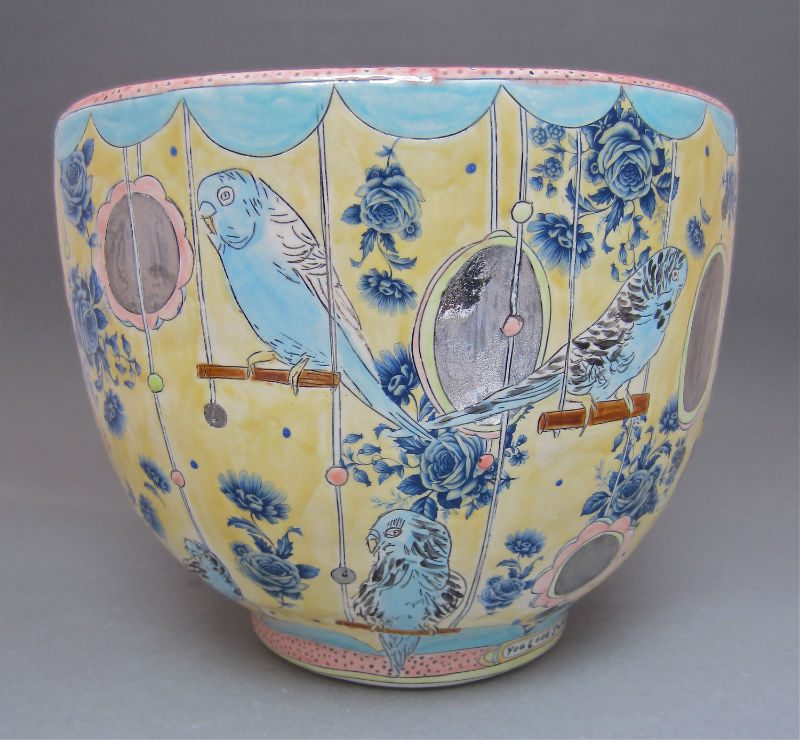Blog / 2016 / How to Keep On Keeping On
November 1, 2016
WORST CASE SCENARIO: You’re preparing for a solo show. The works are mostly completed, ready for final assembly. You tuck the pieces into a shipping container to send them to a gallery on another continent. Meanwhile, you do the smart thing by taking a bit of a vacation. Then, in the middle of your hard-earned frolicking, you receive a phone call describing the terrible storm that swept a number of containers off the ship, yours among them. Your work is at the bottom of the ocean.
Actually, if you’re the Australian sculptor and jewelry-maker Margarita Sampson, you’ve lost a lot more than the one show. That container held most of her life, including three years worth of art that she’d made while living in Germany as well as her computer with documentation of her work from her entire career. This was the late 90s, and there was no such thing as cloud computing, so her record as an artist—the tangible evidence of her identity—was gone.

It’s enough to ruin a person and their creativity, but Sampson came back strong. And for the purposes of this article, she’s teamed up with the Canadian ceramicist Mariko Paterson and myself to tell you how to keep going when the art-making gets tough:
- Do not continue as if nothing is happening.
- Get help.
- Practice self-love.
- Embrace the idea of success through failure.
- Check in with whether or not you could do something else with your life.
- Focus on where your art comes from and nurture that place in yourself.
If you’re ignoring the problem, that denial is only going to hit back harder later on. Acknowledge the difficulty, however big or small, and give it space. You can do this by taking a conscious break from art-making or by doing the exact opposite.
In building a home for the hardship in your studio and making art about it, you’re creating the possibility that one day this home will become a boat or an airplane. It will become a way for that difficulty to finally leave you with just lessons and memories.
Sampson wishes she’d done just that when she arrived in Australia where her solo show was to happen. Instead of making art about the ego-obliteration she had just suffered, she did her best to carry on, rescheduling the exhibition and recreating the works that had been lost. The results were “lackluster” by her own description. Afterwards, she stopped making art. She opened a bookshop and a café, a business that consumed her for three years until she finally returned to art-making. Still, it was ten years after the storm stole her stuff that Sampson felt like she hit her stride as an artist again.
Paterson did more to acknowledge a difficult aspect of her career, that nagging feeling that she should transition from teaching artist to full-time artist. For years, she taught art at various colleges. While the work was rewarding, finding a new gig and moving every year to follow the available positions left her demoralized.
A number of conversations punctuated her realization that she needed to find a way to be an artist without the regular paycheck that professorships provided. One was a question from an upper level student who asked: “what is it like to be a professional artist?” Paterson had been in school, preparing for this teaching moment for years, but she had no answer. As she tells it: “swallowing her question was like swallowing a key that bubbled and burned in my gut for many years to come.”
Find a friend or a therapist, a guru or a tarot card reader, someone who can provide perspective on the problem and help you get back to yourself. Paterson and Sampson both rely on regular feedback to keep on track, with Paterson favoring the more unorthodox guides.
For example, to help her move towards full-time creating, she worked with a shaman. This individual explained that each of us is born with an enormous amount of energy: we’re full of hope, joy, and positivity. As we live, we lose this energy to people who, often without knowing, sap it. The shaman focused on teaching her to not give her strength away and helped her learn how to fill herself back up.
I take a slightly different approach. If my mood is too blue and no one else can inspire me, my go-to people are those individuals who told me I would never be an artist and that I shouldn’t even try. When I’m in a crisis, I think of these people, repeating the things they’ve said to me, worrying my memories of them like stones in my pocket. The possibility of proving these naysayers wrong—of defying their narrow and colorless reality—is always enough of a spark to get me moving again.
This includes eating well, exercising, and putting an end to negative self-talk. As artists, we are our own worst critics. The brutality we are capable of is shocking. Remembering to be compassionate with ourselves is both harder than it sounds and more important than we might think.
Paterson emphasizes that it’s not only a matter of being kind to ourselves, but also of being mindful of the elusive state of self-love—those fleeting moments when you feel confident, capable, intelligent, and generous.
What’s more, as part of her commitment to self-love, Paterson has not gone without cognitive therapy since she was diagnosed with chronic depression in the late 90s. The work she has done with this help allows her to more effectively manage her everyday stress as well as the more complex stuff, like pressure from family members to live differently.
No one ever did anything worthwhile without a few false starts or hiccups along the way. When you think back on something you’ve done and cringe, try letting go of the anxiety. Instead, recognize that the squirmy feeling in your belly means that you did something, following through where so many simply plan and dream and talk. It also means that you kept at it over the course of many years. If you weren’t still an artist, you probably wouldn’t care about a less-than-perfect thing you did at the beginning of your career. Your embarrassment over a past choice means that your taste has evolved. Mistakes aren’t harmful; they’re a confirmation of our artist selves.
Paterson encouraged her students to be comfortable with the notion that they’d probably take two steps back for every step forward. She reminded them to “welcome the potholes of life [because] without potholes we wouldn’t enjoy the smooth patches.”
Sampson acknowledges the role the shipping container accident played in loosening her attachment to possessions and loosening her up in general. It helped her to see her work as ultimately ephemeral, an attitude that helps her to understand difficulties as transitory as well.
If you’re feeling overwhelmed with everything it means to be an artist, take a minute to imagine yourself as anybody else. If you’ve worked other jobs, recalling those experiences might be enough to send you running back to the delicious haven of your studio. That said, if you’re feeling genuine nostalgia for a former employment or if you’re enjoying visualizing another kind of work, it might just mean you’re ready for some changes. Pinpoint where the warm fuzzies are coming from. Is it the regular paycheck that has you daydreaming? How could you get that while still making art? Maybe you’re reminiscing about how social other jobs have been. Could a group studio setting fulfill your people needs?
Or maybe, like me, you literally cannot conceive of doing anything else, and that in itself is enough of a reason to redouble your efforts. For my part, it’s the limitations of my body that keep me on the artist’s path. I suffer from endometriosis and the idea of doing regular work on anyone else’s schedule is absurd. I could feel stuck in my situation, but I choose to see my inability to do anything else as a blessing. The fact that I’m unsuited to any other employment drives me to keep growing in my art practice.
In a static world, we would remain centered and self-aware without effort, but life is a dynamic thing that’s always throwing new information and situations at us. We have to get good at checking in with ourselves regularly.
Sampson describes her process as a stripping away of every reason for making art that comes from outside of her—things like recognition, approval, and her identity as an artist. She recommends that you “burrow right down into that originating impulse [because] it’s the only thing...that will sustain you.”
My method for centering myself is oddly outward facing. When I’m struggling, it helps me to be conscious of the contribution that artists make to society, to recognize the role artists play in helping their communities dream. If I can reconnect with the way that art changes a viewer’s perspective in big or small ways, I can return to making refreshed.
No matter what techniques you use to rediscover your core as an artist, Sampson reminds us that, if we’ve known it previously, we can find it again. That is no small comfort when we’re discouraged or disappointed, convinced that we’ll never find our way home.

Hard times are part of the adventure. If we could lift ourselves out of the difficult moments, we would see them for what they are: moments in time. And each of these steps for making it through whatever complication is currently plaguing us has that as its goal. With a solid sense of perspective, difficulties don’t get blown out of proportion, and they suddenly start to look interesting, worthwhile, and maybe even a little bit fun.
PLEASE NOTE
This article was originally published in Professional Artist magazine, which I don’t write for anymore.
Maybe this post made you think of something you want to share with me? Or perhaps you have a question about my art? I’d love to hear from you!
To receive an email every time I publish a new article or video, sign up for my special mailing list.
If you enjoyed this post, Ko-fi allows you to donate. Every dollar you give is worth a bajillion to me!



